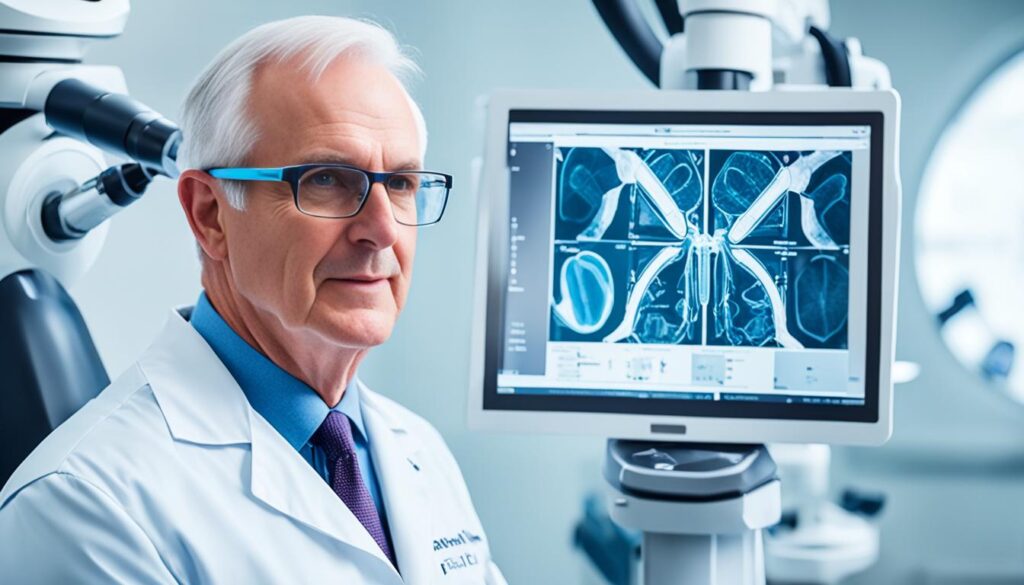Medically reviewed by Dr Chandril Chugh,
Renowned Neurologist and American Trained Specialist
When it comes to treating prostate cancer, you have several options to consider. Understanding these treatment options is crucial for making informed decisions about your health. This article will guide you through the various prostate cancer treatments available, as well as the advancements that have been made in this field. Whether you are newly diagnosed or seeking information for a loved one, this article will provide valuable insights into prostate cancer treatment options and the latest breakthroughs.
Table of Contents
ToggleKey Takeaways:
- Prostate cancer treatment options are diverse, ranging from active surveillance to targeted therapies.
- Advancements in prostate cancer treatment include the use of genomic testing and combination therapies.
- Active surveillance and watchful waiting are suitable for early-stage and slow-growing prostate cancer, with treatment being reserved for later stages.
- Local treatments, such as surgery and radiation therapy, aim to remove or destroy cancer cells within the prostate gland.
- Hormonal therapy is the primary treatment for advanced prostate cancer, aimed at suppressing male hormone activity.
Active Surveillance and Watchful Waiting
Active surveillance and watchful waiting are two approaches commonly used for early-stage and slow-growing prostate cancer. These strategies aim to delay or avoid immediate treatment in order to minimize potential side effects and maintain your quality of life.
Active surveillance is often recommended for men with low-risk prostate cancer or those who have chosen to closely monitor the progression of their cancer. This approach involves regular tests and evaluations to assess the cancer’s status. By closely monitoring the cancer, your doctor can identify any signs of progression and determine if treatment is necessary.
- Regular PSA tests: This blood test measures the levels of prostate-specific antigen, a protein produced by prostate cells. Elevated PSA levels may indicate the need for further investigation.
- Digital rectal exams (DRE): During this examination, your doctor will use a gloved finger to check for any abnormalities or changes in the size, shape, or texture of the prostate gland.
Watchful waiting, on the other hand, may be recommended for older adults with other serious health conditions or those who would experience more harm than benefit from aggressive treatments. With watchful waiting, treatment is reserved for symptom management and addressing the patient’s overall comfort.
“Active surveillance is like looking out for any changes that may indicate a cancer growth spurt, while watchful waiting is more about focusing on your overall well-being and managing symptoms as they arise.”
It’s important to note that active surveillance and watchful waiting are not passive approaches. They involve close collaboration with your healthcare team through regular check-ups and discussions to reassess the need for treatment based on changes in test results, worsening symptoms, or urinary tract obstructions.
By opting for active surveillance or watchful waiting, you have the opportunity to balance the potential risks and benefits of immediate treatment. This approach allows you to retain your peace of mind and actively participate in the decision-making process regarding your prostate cancer management.

Benefits of Active Surveillance and Watchful Waiting
Active surveillance and watchful waiting offer several advantages:
- Minimization of treatment side effects: Delaying or avoiding immediate treatment can help reduce the risk of side effects associated with surgery, radiation therapy, or hormonal therapy.
- Preservation of quality of life: By avoiding unnecessary treatments, you can maintain your normal daily activities, sexual function, and urinary control.
- Protection against overtreatment: Active surveillance and watchful waiting prevent overdiagnosis and overtreatment of slow-growing and low-risk prostate cancers that may never pose a significant threat to your health.
Remember, active surveillance and watchful waiting should only be considered under the guidance of your healthcare team. They will assess your individual case and determine the most appropriate course of action based on your specific circumstances.
Local Treatments: Surgery and Radiation Therapy
When it comes to treating prostate cancer, local treatments like surgery and radiation therapy play a crucial role in removing or destroying cancer cells within the prostate gland. These treatments can significantly impact a patient’s prognosis and quality of life. Let’s explore the different options available:
Surgery Options
One of the surgical options for prostate cancer is radical prostatectomy. This procedure involves the complete removal of the prostate gland, and in some cases, nearby lymph nodes are also removed. Radical prostatectomy aims to eliminate the cancer cells entirely. To help preserve sexual function, nerve-sparing techniques may be used during the surgery.
Another surgical option, called transurethral resection of the prostate (TURP), is primarily used to relieve urinary blockage caused by an enlarged prostate. While TURP can alleviate urinary symptoms, it’s not considered a primary treatment for prostate cancer.
Radiation Therapy
Radiation therapy is another local treatment option for prostate cancer. It utilizes high-energy beams to target and kill cancer cells. There are two common methods of radiation therapy used:
- External beam radiation therapy: This approach involves delivering radiation from a machine outside the body. The radiation is aimed at the prostate gland to destroy the cancer cells. External beam radiation therapy is typically performed over multiple sessions.
- Brachytherapy: This treatment involves placing tiny radioactive seeds inside the prostate gland. These seeds release radiation directly to the prostate over time, effectively killing the cancer cells. Brachytherapy can be performed as a one-time procedure or in combination with external beam radiation therapy.
The choice between surgery and radiation therapy depends on various factors, such as the patient’s cancer stage, overall health, and individual preferences. It’s essential to consult with a healthcare professional to determine the most suitable treatment option for each unique case.
As we continue to make advancements in the field of prostate cancer treatment, these local treatments remain integral in the fight against the disease.

Hormonal Therapy
Hormonal therapy, also known as androgen ablation therapy, is the primary treatment for advanced prostate cancer. It aims to suppress the production and activity of male hormones, particularly testosterone, which fuels the growth of prostate cancer cells.
This therapy may involve the use of different drugs, such as:
- LHRH analogs
- LHRH antagonists
- Antiandrogens
These therapies work to reduce testosterone levels and slow down the progression of the disease. However, it is important to note that hormonal therapy is not a cure for prostate cancer, but rather a way to manage and control the disease.
While hormonal therapy is effective in treating prostate cancer, it can also have side effects. Some common side effects include:
- Loss of sex drive
- Impotence
- Weakened bones
- Heart problems
Regular monitoring and discussions with your healthcare provider can help manage and address these side effects effectively.
Research Quote:
“Hormonal therapy plays a crucial role in the treatment of advanced prostate cancer. By targeting the hormones that stimulate cancer growth, we can effectively slow down the progression of the disease.”
| Hormonal Therapy Option | Description | Examples |
|---|---|---|
| LHRH analogs | These drugs work by blocking the production of hormones in the testicles. | Leuprolide (Lupron), Goserelin (Zoladex), Triptorelin (Trelstar) |
| LHRH antagonists | These drugs work by directly blocking the hormone receptors in the pituitary gland. | Degarelix (Firmagon) |
| Antiandrogens | These drugs block the action of testosterone on prostate cancer cells. They can be used alone or in combination with other hormonal therapies. | Flutamide (Eulexin), Bicalutamide (Casodex), Nilutamide (Nilandron) |
In some cases, a combination of these therapies may be recommended to achieve better outcomes in managing advanced prostate cancer.

Chemotherapy
Chemotherapy is an important treatment option for patients with castrate-resistant prostate cancer (CRPC) when hormone therapy is no longer effective. It involves the use of powerful drugs to target and destroy cancer cells, helping to improve overall survival.
The standard chemotherapy drug for CRPC is docetaxel, often combined with prednisone. Docetaxel works by inhibiting the division and growth of cancer cells, helping to slow down the progression of the disease. It is typically administered intravenously every few weeks.
When prostate cancer progresses after docetaxel treatment, another chemotherapy drug called cabazitaxel may be used. Cabazitaxel works in a similar way to docetaxel, providing an additional option for patients who need further treatment.
Chemotherapy can be effective in controlling advanced prostate cancer and improving overall survival, but it does come with potential side effects. These can include nausea, hair loss, lowered blood cell production, and fatigue. However, advances in supportive care have helped to manage and alleviate these side effects, improving the quality of life for patients undergoing chemotherapy.
It is important to consult with your healthcare provider to determine if chemotherapy is the right treatment option for your specific case of prostate cancer. They can provide personalized guidance based on your individual needs and help you understand the potential benefits and risks of chemotherapy.
Targeted Therapy and Immunotherapy
Targeted therapy and immunotherapy are two innovative approaches in the treatment of prostate cancer. These therapies offer a more precise and personalized approach to tackling the disease, targeting specific cancer cells and harnessing the power of the body’s immune system.
Targeted Therapy
Targeted therapy involves using drugs that specifically target cancer cells with certain genetic mutations. One example of targeted therapy is the use of PARP inhibitors, which impair the cancer cells’ ability to repair DNA damage. By inhibiting this repair mechanism, targeted therapy can halt the growth and spread of prostate cancer.

A potential benefit of targeted therapy is its ability to spare healthy cells from unnecessary damage, reducing the risk of side effects compared to conventional treatments like chemotherapy. This approach holds great promise for patients with prostate cancer, particularly those with specific genetic markers that make them more prone to the disease.
Immunotherapy
Immunotherapy aims to utilize the body’s own immune system to recognize and attack cancer cells. In the case of prostate cancer, treatments like Sipuleucel-T, known as a “vaccine,” are used to stimulate the immune system’s response against prostate cancer cells. This therapy helps the immune system to recognize the cancer cells as foreign and mount a targeted attack.
“Immunotherapy has the potential to revolutionize prostate cancer treatment by improving outcomes and reducing side effects.”
Checkpoint inhibitors, such as pembrolizumab, are also being investigated for their efficacy in treating certain types of prostate cancer. These inhibitors release the “brakes” on the immune system, enabling it to effectively target and destroy cancer cells.
Comparison of Targeted Therapy and Immunotherapy
| Aspect | Targeted Therapy | Immunotherapy |
|---|---|---|
| Purpose | Specifically target cancer cells with genetic mutations | Stimulate the immune system to recognize and attack cancer cells |
| Mechanism of Action | Impair cancer cells’ ability to repair DNA damage | Activate the immune system to mount an anti-cancer response |
| Side Effects | May have fewer side effects compared to conventional treatments | Can be associated with immune-related side effects, which are generally manageable |
| Applicability | Particularly effective for prostate cancer patients with specific genetic mutations | May be beneficial for a wider range of prostate cancer patients |
While targeted therapy and immunotherapy offer exciting prospects for the treatment of prostate cancer, it’s important to note that these therapies are still evolving and undergoing clinical trials. They may not be suitable for all patients, and further research is needed to fully understand their long-term effectiveness.
As advancements continue to be made in targeted therapy and immunotherapy, they hold the potential to significantly improve outcomes for prostate cancer patients. These approaches offer new avenues of hope, paving the way for more personalized, effective, and tolerable treatments in the future.
Advanced Treatment Techniques
Prostate cancer is a complex disease that requires innovative treatment approaches. Advanced treatment techniques are playing a crucial role in the management of prostate cancer, providing more targeted and effective options for patients. One such technique that shows promise is targeted radiation therapy.
Targeted radiation therapy utilizes molecules that bind to a protein called prostate-specific membrane antigen (PSMA), which is found in high amounts on prostate cells. By attaching a radioactive compound to these molecules, the therapy can precisely detect and destroy prostate cancer cells throughout the body. This targeted approach minimizes damage to healthy tissues and reduces side effects.
Clinical trials investigating targeted radiation therapy have shown promising results, particularly in patients with advanced and metastatic prostate cancer. This technique offers new hope for individuals who may not have responded well to traditional treatments. By delivering radiation directly to cancer cells, targeted radiation therapy can effectively destroy tumors and improve outcomes.
Benefits of Advanced Treatment Techniques:
- Precise targeting of cancer cells
- Reduced damage to healthy tissues
- Improved treatment outcomes
- Reduced side effects
Case Study: Targeted Radiation Therapy
“I was diagnosed with advanced prostate cancer, and I felt like I had exhausted my treatment options. That’s when my doctor suggested targeted radiation therapy. It was like a ray of hope for me. I underwent the treatment, and the results have been remarkable. My PSA levels have decreased, and I’m experiencing fewer side effects. I’m grateful for this advanced technique.”
– Prostate Cancer Survivor
Comparing Treatment Techniques
| Treatment Technique | Benefits |
|---|---|
| Targeted Radiation Therapy | Precise targeting of cancer cells, reduced damage to healthy tissues, improved treatment outcomes, reduced side effects |
| Surgery | Potential for complete removal of cancer, nerve-sparing techniques to preserve sexual function, risk of side effects such as incontinence and erectile dysfunction |
| Radiation Therapy | Effective in killing cancer cells, non-invasive, potential side effects such as fatigue and urinary problems |
| Hormonal Therapy | Decreased testosterone levels, slowing down cancer progression, potential side effects such as loss of sex drive and weakened bones |
| Chemotherapy | Effective for advanced prostate cancer, potential side effects such as nausea and hair loss |
| Immunotherapy | Activation of the immune system to fight cancer, potential side effects such as fatigue and flu-like symptoms |
As advancements in treatment techniques continue to unfold, patients can benefit from improved outcomes and enhanced quality of life. Targeted radiation therapy, along with other innovative approaches, provides hope for individuals navigating the complexities of prostate cancer treatment.

Personalized Clinical Trials and Research
Personalized clinical trials are at the forefront of prostate cancer research, driving the exploration of new and innovative treatments. Researchers are delving into the genetic changes that occur in prostate cancers, aiming to identify potential targets for the development of novel drugs. These clinical trials take a targeted approach by enrolling participants based on the specific genetic mutations present in their cancer, rather than focusing solely on the cancer’s origin.
By personalizing clinical trials, scientists can gain valuable insights into how different genetic profiles respond to various treatments, ultimately leading to more tailored and effective approaches. This groundbreaking research holds the potential to revolutionize prostate cancer treatment, offering hope to patients who may have limited or no response to standard therapies.
Ongoing studies in prostate cancer research are also exploring innovative treatments that go beyond traditional approaches. Combination therapies, which involve using multiple treatments in tandem, are being investigated to improve outcomes and increase treatment efficacy. Additionally, researchers are exploring ways to enhance the immune system’s recognition of prostate tumors, paving the way for the development of immunotherapies that harness the body’s natural defenses to fight cancer.
Novel Treatment Approaches
In the realm of personalized clinical trials and research, several novel treatments show promise for prostate cancer patients:
- Targeted Molecular Therapies: Researchers are developing targeted therapies that specifically address the genetic alterations responsible for prostate cancer. These therapies focus on inhibiting specific molecules or pathways involved in cancer growth, offering a more precise and effective treatment option.
- Gene Therapy: Investigational studies are exploring the potential of gene therapy, where genes are introduced into the body to replace or repair faulty genes responsible for prostate cancer. This approach aims to halt or slow the progression of the disease by correcting the underlying genetic abnormalities.
- Immunotherapies: Immunotherapies are designed to harness the power of the immune system to recognize and destroy cancer cells. These treatments can vary from immune checkpoint inhibitors that release the immune system’s brakes to cellular-based therapies that enhance the body’s natural cancer-fighting abilities.
As the field of personalized clinical trials and research continues to evolve, new treatment options and breakthroughs are on the horizon. By targeting specific genetic mutations and exploring innovative therapies, researchers aim to improve prostate cancer outcomes and enhance the quality of life for patients.

| Trial | Purpose | Targeted Genetic Mutation | Treatment |
|---|---|---|---|
| TRITON3 | To evaluate the efficacy of a PARP inhibitor in patients with specific DNA repair gene mutations | BRCA1, BRCA2, or ATM mutations | Rucaparib |
| KEYNOTE-365 | To study the effectiveness of pembrolizumab in patients with advanced prostate cancer | PD-L1 expression or mismatch repair deficiency | Pembrolizumab |
| VISION | To assess the impact of PSMA-targeted radioligand therapy on overall survival in men with metastatic prostate cancer | Prostate-Specific Membrane Antigen (PSMA) | Lutetium-177 PSMA-617 |
Conclusion
Prostate cancer treatment options have evolved significantly in recent years, providing patients with a diverse range of therapies to consider. When making treatment decisions, it is crucial to engage in discussions with healthcare providers and gain a comprehensive understanding of the goals of treatment, potential side effects, and how different options may impact recurrence, survival, and quality of life.
Advancements in prostate cancer treatments have shown promise in enhancing outcomes for patients. Targeted therapies and immunotherapies are particularly noteworthy, as they offer new avenues for improving treatment response and long-term prognosis. These innovative approaches are designed to specifically target cancer cells and mobilize the body’s immune system to fight against the disease.
Ongoing research and clinical trials continue to play a vital role in expanding our knowledge of prostate cancer and offering hope for more effective treatments in the future. By exploring new treatment modalities, combinations of therapies, and ways to enhance the immune system’s recognition of prostate tumors, researchers and clinicians strive to improve patient outcomes and overall quality of life.
FAQ
What are the treatment options for prostate cancer?
Treatment options for prostate cancer include active surveillance, surgery, radiation therapy, hormonal therapy, chemotherapy, immune therapy, and targeted therapy.
What is active surveillance?
Active surveillance is an approach used for early-stage and slow-growing prostate cancer. It involves closely monitoring the cancer for signs of progression while delaying treatment to avoid potential side effects.
What is watchful waiting?
Watchful waiting is often recommended for older adults or those with other serious illnesses. Treatment is reserved for alleviating symptoms, and regular tests are conducted to evaluate the cancer’s status.
What are the local treatments for prostate cancer?
Local treatments for prostate cancer include surgery and radiation therapy. Surgery options include radical prostatectomy and transurethral resection of the prostate (TURP). Radiation therapy can be done using external beam radiation therapy or brachytherapy.
What is hormonal therapy?
Hormonal therapy, also known as androgen ablation therapy, is the primary treatment for advanced prostate cancer. It aims to suppress the production and activity of male hormones, particularly testosterone, which fuels the growth of prostate cancer cells.
When is chemotherapy used for prostate cancer?
Chemotherapy is used when hormone therapy is no longer effective in controlling advanced prostate cancer, a stage called castrate-resistant prostate cancer (CRPC).
What is targeted therapy?
Targeted therapy involves using drugs that specifically target cancer cells with certain genetic mutations. These drugs impair the cancer cells’ ability to repair DNA damage.
What is immunotherapy?
Immunotherapy aims to harness the immune system to fight cancer cells. Treatments like Sipuleucel-T stimulate the immune system to recognize and attack prostate cancer cells.
What are advanced treatment techniques for prostate cancer?
Advanced treatment techniques for prostate cancer include targeted radiation therapy, which utilizes molecules that bind to prostate-specific membrane antigen (PSMA), a protein found in high amounts on prostate cells.
What are personalized clinical trials and research for prostate cancer?
Personalized clinical trials are conducted to explore new and innovative treatments for prostate cancer. Researchers are investigating the genetic changes that occur in prostate cancers and identifying potential targets for new drugs.
